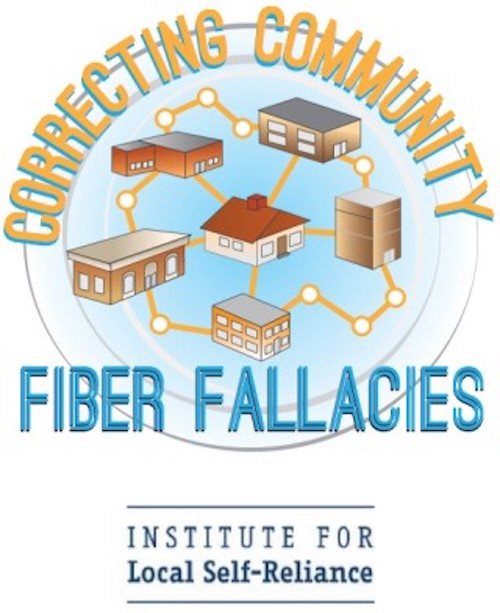Podcast (buildinglocalpower): Play in new window | Download | Embed
Subscribe: RSS
This week in Building Local Power, we’re discussing how concentrated economic power responds to communities that are supporting their own local economies. Guest host Nick Stumo-Langer discusses how these corporations fight against local communities with a number of ILSR’s experts. He speaks with Stacy Mitchell, John Farrell, Christopher Mitchell, and Lisa Gonzalez in order to get a large spectrum of opinions from across different economic sectors.
As our experts argue during the podcast, corporations use flawed, assumption-ridden academic studies; public fear and ignorance of technical economic issues; and products and policies that attempt to masquerade as “local” when they are actually created by large companies.
“What we’re seeing are more communities stand up for themselves, and try to chart their own future,” says Stacy Mitchell of why companies are seeking to attack communities’ autonomy. “It’s that a lot of companies are coming in, and they’re either using false information or a sense of fear, or other manipulative tactics to try to get their own way and to block communities from being able to do what they want to do. And sometimes, we even see them, you know, using really sort of stealth means to kind of co-opt local markets.”
Get caught up with the latest work from the Institute for Local Self-Reliance on fighting monopoly power across a variety of sectors:
Here are the reading/watching recommendations from the group this week:
From Stacy Mitchell: |
From John Farrell: |
From Christopher Mitchell: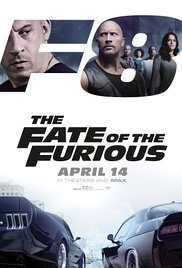  |
From Lisa Gonzalez: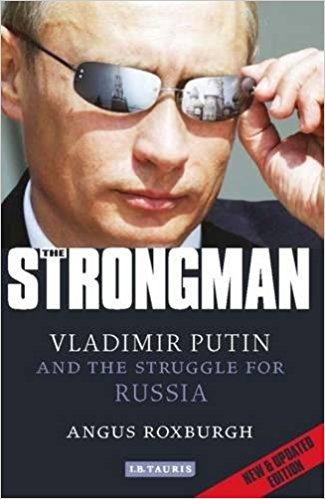 |
From Nick Stumo-Langer: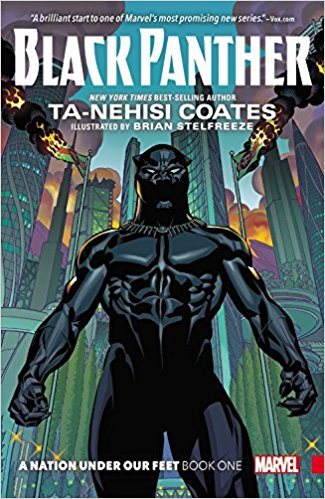
 |
| Nick Stumo-Langer: | So, Lisa, I hear you have a statistic you’re bringing to the podcast today? |
| Lisa Gonzalez: | I do. In fact, Pew Research put out a new report not long ago. They surveyed some people, a large number of people, and 70 percent of those people were in favor of the idea of municipal networks, 70 percent. |
| Nick Stumo-Langer: | That’s a huge percentage. That must mean we have great policies, and that the big companies are following public opinion on this, right? |
| Lisa Gonzalez: | Oh, well. Maybe that’s not exactly what it means. |
| Nick Stumo-Langer: | All right well, let’s dig into this a little more on this episode of Building Local Power. My name is Nick Stumo-Langer, and I’m the Communications Manager here for The Institute for Local Self Reliance. And on the line with me is Lisa Gonzalez, the Senior Researcher for the Community Broadband Networks Initiative. So, say hi, Lisa. |
| Lisa Gonzalez: | Hi, Lisa. I mean, hi, Nick. |
| Nick Stumo-Langer: | And, today is going to be a little bit different format for the podcast. We’re going to a little bit of round table with some of our experts, just talking about the ways that large companies and concentrated economic power is reacting to local communities asserting their will and building local power. So, why don’t we dig into this with our Co-director and the Initiative Director of the Community Scaled Economies Initiative, Stacy Mitchell. |
| Stacy Mitchell: | Hey, Nick. |
| Nick Stumo-Langer: | Hi Stacy, so why don’t we kind of frame this issue a little bit. And, maybe just do a little discussion on what we’re talking about, and how these big corporate entities are reacting to communities that exert local power? |
| Stacy Mitchell: | Well, what we’re seeing are more communities stand up for themselves, and try to chart their own future. It’s that a lot of companies are coming in, and they’re either using false information or a sense of fear, or other manipulative tactics to try to get their own way and to block communities from being able to do what they want to do. And sometimes, we even see them, you know, using really sort of stealth means to kind of co-opt local markets. |
| Nick Stumo-Langer: | What kind of fears are they stoking? How are they, what kind of apocalypse are they crafting for these local communities? |
| Stacy Mitchell: | At the community scaled economy initiative, we work a lot on consolidation and particularly big retailers. And so, we help a lot of communities fight Wal-Mart and Target and other big companies from coming in, support local businesses.
And, one of the things we see in those fights when say Wal-Mart wants to build a store, and a community’s like, “No, we think you’ve got enough market power here, you don’t need any more stores in our area, or we want to place limits on you, you can’t build such a big store, or you have to pay higher wages, or in some other way, really benefit the community.” What we see Wal-Mart often doing is running these very elaborate public relations campaigns, where they basically say you know, “If you don’t let us in, your whole economy’s going to tank. You’re not going to have jobs. We’re just going to go to the town next door and build there, and we’ll destroy your local economy anyway. You know, that you’re going to get left behind.” And, of course, in this economy when a lot of people are really struggling to make ends meet, you know, the idea of losing out on jobs, and growth is a big deal. And so that can really work in Wal-Mart’s favor, if they’re effective at doing it. |
| Nick Stumo-Langer: | It seems like a really insidious form of fear of missing out, FOMO. Except the end result seems to be that your economy will be destroyed. |
| Stacy Mitchell: | Yeah, and it’s all kinds of evidence that shows exactly the opposite. That places that say “no” to big retailers are better off economically, they have higher median incomes, more income growth, more job growth. I mean, in all sorts of ways, the evidence really shows the opposite.
But it’s very easy for a big company like that to say, “Hey look, we’re going to create these jobs, we’re going to grow your economy.” And, it seems truthful on the face of it. One of the other things we often see is companies will kind of do this inversion where they play to people’s fear about being controlled by an outside entity. And, even though, in reality, they’re the outside entity that wants to come in and control the local economy, what they do is place that on the city council. And so, they create this campaign, like the city council is like some kind of like global government coming in and, you know, trying to intervene in the community’s future, and so on. Your city council’s like made up of your neighbors. I mean, the city council, your government is you, especially at the local level, right? You know, but Wal-Mart will often, you know, sort of, run this public relations campaign like city government is just, you know, like black helicopters from the UN are coming in to interfere and, you know, your small town in Montana. And, of course, in reality, what you have is this global corporation, you know, that’s bigger than many of the economies of the world, actually coming in and wanting to rearrange your local community for its own benefit. That’s the truth of the matter. But, they do this sort of inversion process. |
| Nick Stumo-Langer: | So, you’ve got the situation where, in a lot of ways, you have a big entity, like Wal-Mart or other big box retailers, and they’re coming in, they’re squeezing out these local businesses. But, I’m wondering if you can talk a little bit about the concentration in products, or the ways in which, you know, you have certain local products that are really great, you know, craft beer is a good example of this, that’s being co-opted by larger and larger entities. Maybe talk a little bit about something I know you call “local washing”. |
| Stacy Mitchell: | Yeah, I mean, this is interesting, because as we’re winning, as we’re seeing this growth in craft beer and local food, you know, we’ve seen some return of independent retail. There’s a lot of interest in growing public support for those, you know, kinds of locally produced products. And so, what companies have begun to do is they’ve created, like a stealth version of local. So, for example, in the craft brewing space, there are a lot of craft beers that have been bought by Miller’s, Coors, or by AB InBev, Anheuser-Busch, and they continue to operate them as though they’re craft beers.
You wouldn’t know standing in the grocery store aisle that it’s not an independent craft beer, but it isn’t anymore. Some examples of this are Goose Island, you know sort of a famous craft brewery in Chicago, which is now owned by Anheuser-Busch. Golden Road in Los Angeles, also owned by Anheuser-Busch. You know, even Brooklyn Brewery now is 25 percent stake in one of the largest, you know, 25 percent of it is owned by one of the largest brewers in the world. And so, this is one way that these companies are coming in and sort of tricking people into buying their products. People who are actually seeking out a locally produced craft beer. Even Wal-Mart actually has its own craft beer. It’s called Trouble Brewing and it’s got all the, if you see the packaging, it’s got all the hallmarks of an actual craft beer. You know, they make a Belgian style wheat beer called Round Midnight. And they sell it at all their stores. It’s mass-produced through a private label arrangement and they tuck it in with the other craft beers. It’s not sold alongside Coors or Miller, it’s there with the craft beers and you would think that it’s a local craft brewery, but in fact it’s a Wal-Mart beer. |
| Nick Stumo-Langer: | That sounds really disturbing, and I think Trouble Brewing is probably the best name I could think of for it. I’ll share a little anecdote, I was in Chicago on a little trip. Back out east here, to DC, and I was walking around downtown Chicago. And, I did notice there was a local pharmacy that had the name of the neighborhood on it. And, you know, in very small letters on the bottom, it said, “A Rite Aid affiliate pharmacy.” And, that was something that was especially insidious that I definitely noticed, and I’m wondering, have you seen that in other places where, you know, big retailers have grabbed up small local pharmacies, or other retail businesses that they can just pass off as local? |
| Stacy Mitchell: | Yeah, you know funeral homes is a big one. Some big funeral home chains have rolled up all these local funeral homes, and they’ve kept the local name. And so, you know, you would think that it was still local.
Starbucks has quite a few stealth coffee shops. If you look very closely at the fine print somewhere in the space, it will say by Starbucks. But, you have to be really looking out. They all have unique names. There’s one in Seattle that’s called like 15th and something, you know, it’s like the name of the actual street location. And they look like, it’s got like reclaimed wood, it has all the hallmarks of an independent coffee shop that Starbucks has adopted. You know, even online, like Amazon, they’re manufacturing more and more of the stuff that they sell, and so, one area they’re making a big push in is clothing. They’re producing a lot, they’re selling more and more clothing, and they’re producing a lot of the clothing that they sell. But of course, most people, you know, maybe you’d buy Amazon branded socks, but you, you know, the idea of buying like an Amazon cocktail dress isn’t, you know, that’s not really very appealing. So, what Amazon has done, is they’ve created all of these labels like Larkin Ro is one of them that sells women’s fashions, you know, and you would think this is some kind of independent fashion brand, but in fact, it’s Amazon-made clothing. |
| Nick Stumo-Langer: | All right Stacy, well, thank you so much for joining us today for the podcast. And, do you have any recommendations you’d like to give to our listeners? For, you know, future reading or watching or listening? |
| Stacy Mitchell: | You know, I’ve been on vacation so I’ve been, you know, catching up on spy mysteries by Alan Furst, which is a lot of fun, but not really germane to our work. |
| Nick Stumo-Langer: | No, I think that’s fine. I’d love to, like I said before, I’m going to be recommending a comic book at the end of this, so stay tuned for that. And, it doesn’t always have to be about local economy stuff. And, that’s just fine. Thank you so much, Stacy. |
| Stacy Mitchell: | Thanks, Nick. |
| Nick Stumo-Langer: | Our next guest is Energy Democracy Initiative Director, John Farrell, and he’ll be talking to us about the way that electric utilities are stoking some fear around renewable energy. John, welcome to the show. |
| John Farrell: | Thanks, Nick. |
| Nick Stumo-Langer: | So, why don’t you just give our audience a little bit of an overview of the kind of big issues you see around renewable energy, and how utilities are stoking public ignorance about this? |
| John Farrell: | Well, really, the key to understanding what’s happening with utilities and with renewable energy is that for about 100 years, utilities have had a monopoly over the production of energy in our electricity system. And so, they’re not used to competition. And, entrance of new ways of producing energy, particularly solar power, which can be done at small scale, it can be done on rooftops, it can owned by customers, is really a threat to their market share, and that’s the way that they perceive it. And so, you see them acting in a lot of different ways to resist the incursion of this competition into a market that they have comfortably controlled for decades. |
| Nick Stumo-Langer: | That sounds like a big deal, and it sounds like a lot of fear around their own profit margins, really, if you’re getting down to it. So, have you seen any, you know, glaring examples of this influence being used to tamp down renewable energy? Especially, locally owned renewable energy? |
| John Farrell: | Yeah, there’s a really good example. And it was good in the sense that it also turned out well for the locals in Florida, in 2016. At the end of 2016, there was an initiative on the ballot that was placed there by the utility companies, and it was in language that couched it as a pro-solar amendment to the constitution in Florida. But, what it really would have done is prohibited the kind of third party competition that the utilities were hoping to avoid.
There are companies now that can come in, and put solar on your roof, and pay most of the upfront cost, and then you just sort of pay them back over time. And, it’s really a policy tool that has been a key part of the success and expansion of solar on both businesses and home rooftops in many different states. And these Florida utilities, who were feeling threatened by this, decided to invest millions of dollars in a ballot initiative, a very deceptive ballot initiative, that touted itself as being pro-solar, but in reality was going to make it very, very difficult for solar to grow in the state of Florida. In ironically, what’s called The Sunshine State. So, they invest in their own utilities, the ones that are owned by, that are private companies, that are owned by shareholders who are many of them not Floridians, spent 20,000,000 dollars on this ballot initiative, and an additional 9,000,000 dollars on political races, like for the legislature and the governor’s office in order to influence this vote. And, were nearly successful, even though it was a 60 percent vote threshold in order to pass and what really undermined them, or caught them up was that a fellow advocate, from some kind of astro turf, if you will, non-profit organization that was purportedly for affordable energy, but was really about defending the utilities’ interests, was caught on tape, discussing this ballot initiative as a sort of form of political jujitsu. That was, you know, quote, “An incredibly savvy maneuver that would completely negate anything the pro-solar advocates would try to do legislatively or constitutionally down the road.” So, it was acknowledged as a very deceptive tactic. And, when that audio was released, it started off a tidal wave of opposition, that eventually lead to the ballot initiative’s defeat. But, it was a very near thing, and the utilities were very closely successful. Florida Power and Light put in 8,000,000 dollars by itself. It’s the largest investor-owned utility in Florida. It was the most that had ever been spent on a ballot initiative, in the history of the state of Florida. And again, they couched it all in this terms of being pro-solar, when really it was all about quashing competition. |
| Nick Stumo-Langer: | So, I want to pull on that thread, just a little bit there. You’re talking about how their couching it in language that’s pro-solar. I think, that’s something that we’ve consistently seen. You have a big company like Wal-Mart, that we talked about in our last segment, it’s coming in and saying, “We want to build your local economy”, that type of thing. Or, you have these large utilities saying, “We want to build up renewable energy, we want to do this type of thing.” How are their tactics really kind of obscuring the issue, and in what way are they actually taking power away from the local communities? Because, you know, there are some people who would say, “Oh, more solar panels sounds great. It doesn’t matter who owns them.” But, why is it important that local communities own the solar, and the renewables, in general? |
| John Farrell: | Well, let me just cover the first thing about, in terms of the nature of the deception. One of the things that they highlighted was safety. And this is a common theme among utilities, who use their, kind of, their sort of trusted as operators of the grid, and so they often couch their defense of their market share in terms of safety. That, “Oh, the grid will be less reliable,” for example, if we let more solar. They actually successfully recruited firefighters in order to appear in ads talking about, you know, rooftop solar as a fire safety risk. In the end, when firefighters realize, that after the release of this audio, that in fact this was a very deceptive amendment, not intended to be at all about safety, and entirely about protecting their monopoly, the firefighters started to disavow that. But, it’s just an indication of one way in which the utilities have this fight.
And what’s really at stake here, is an opportunity for us to fundamentally change the way that we are producing energy, and consuming energy, and really where the dollar flows in our energy system go. You know, we spend 360 billion dollars a year on electricity in the United States. And the technologies, like solar or Smart Phones, or electric vehicles are offering an opportunity for the first time for us to keep those dollars in our own pockets, whether it’s participating by subscribing to a community solar array, or putting solar on our own rooftop, or maybe contributing to doing that on our place of worship. So, there’s so many different ways in which we can really localize the dollars in our energy economy, create more local jobs, and create more competition, frankly, in our energy system. And, the utility companies are, of course, very resistant to this and unfortunately, not willing to fight on fair terms, but rather using the power of their incumbency, you know the fact that they collect all of our money right now, as the monopoly company, to resist this change. |
| Nick Stumo-Langer: | John, that’s a great note to end it on. Thank you so much for joining us. I know you’ve got to run, but do you have a recommendation for our listeners? Anything that you’ve been particularly enjoying? |
| John Farrell: | Again, my reading has been on the fiction, rather than the non-fiction side, but I read an excellent book called Paladin of Souls by Lois McMaster Bujold. I just finished it a couple of days ago, very good. Very good story. And, as someone who’s read a lot of fantasy novels over my lifetime, some very novel approaches to story telling in that book, so I’d recommend it. |
| Nick Stumo-Langer: | That’s great, thank you so much, John. |
| John Farrell: | Thanks, Nick. |
| Nick Stumo-Langer: | And now joining us for a third segment is Lisa Gonzalez, back from the beginning of the show, and Christopher Mitchell, the Director of our Community Broadband Networks Initiative, why don’t you say hi? |
| Chris Mitchell: | Hey, I’m excited to be here.
Hey Nick, you know, in a lot of podcasts right now this is a moment in which you might hear an advertisement, you might hear someone say, “Rocket Home Mortgage is really the best place for you to go and get your mortgages.” And, we know that from a previous show, that’s actually not the case. That, in fact, you’d be much better off sticking with your local banks, to make sure you’re getting the best deal and making sure you’re really supporting that local economy. But, I don’t know if you’ve noticed or not? We don’t have any advertisements in this show, but we are always looking for people to support our work and to make sure we can keep doing it. And so, let me just really encourage you to head on over to ILSR.org, find the donate button, give us a few bucks, and help us to keep it going. So, that’s our advertisement. It is not what we normally hear, but I wanted to make sure people were just thinking about the fact that, if we wanted to take advertising, it would be very difficult. And, one of the reasons you hear from these big national companies on advertising is because local advertising on podcasts can be quite difficult. So support us instead, support your local businesses, and just consider that to be doing your part. Thanks a lot. |
| Nick Stumo-Langer: | Thanks, Chris. So, Christopher Mitchell, everybody, give him your money.
So, why don’t we start with talking about how these large companies are responding to local power in the form of municipal broadband networks? I know, we have a lot to say on this, but Chris, why don’t you just start out giving an overview of the company response to municipal networks? |
| Chris Mitchell: | Well, I think we could break it into two large categories that are not exclusive. But, two things that immediately come to mind are: one, big lobbying campaigns in the state capitals as well as in the federal government to basically prohibit that competition of local community-owned networks; and the second broad category, would be seemingly academic studies or studies from seemingly independent groups that are talking about how municipal networks are bad investments.
We recently just responded to one, which was, you know, I was actually comparing it to Macedonian Fraudsters inventing stories about Pizzagate abductions because it was just, it was so crazy and that was from the Taxpayer Protection Alliance, which has zero credibility in terms of their ability to correctly describe what’s happening factually, let alone a judgment as to whether or not these networks are succeeding. But on the other end of the scale, appearing to be academically rigorous, is a study that just came out from the University Pennsylvania Law School, a professor there, who runs the center on technology that receives a lot of money from big incumbent telephone and cable companies, Christopher Yoo, has released a study, in which he claims that most municipal networks are losing money and will not break even. And, his data is really quite inappropriate for the methodology he used. And, in the next day or so will be releasing a paper that explains the holes in his argument. As well as, I think, some of the bias that we see in it that makes it just seem a little less credible to us. |
| Nick Stumo-Langer: | So, why are these, you know, Taxpayers Protection Alliance, these academics, why are they releasing these types of things, what are they trying to do? Are they trying to keep what we have? Are they trying to change something? What’s their goal? |
| Lisa Gonzalez: | Well, I think that, you know, Christopher already touched on one aspect, and that is, you know, they get a lot of their support from the corporations that are trying to limit competition. But realistically, I think they also believe what they are saying and one of the things about the report that I thought was disturbing, for lack of a better word, is using the methodology that they used to analyze something that was, it was like trying to fit a square peg into a round hole.
We’re talking about a service that is not a nicety, but a necessity. And basically, they’re talking about analyzing something based on net present value. How much cash flow does it make? How much profit does it make? But, there’s a lot more to municipal networks, than just turning a profit. And so, you know, one of the reasons why they do this, I believe, is, first of all, to continue to garner support from the corporations that back them, but also because they believe in what they’re saying. And, we just feel that it’s incorrect and simplistic. |
| Nick Stumo-Langer: | One of the things I would add on to that, and I definitely agree with Lisa, and I think the larger dynamic is not so much that you have an industry that has a ton of money, and therefore people are trying to figure out how to sell out and just lie baldly about their intentions. There’s a little bit of that, and I don’t think that we should discount that. But, you know, a lot of these groups and, particularly the academics, I think, are people that have honest beliefs that the Comcast and AT&T way is the best way. That these economies of scale that come from the larger companies are going to end up doing better for the economy and things like that.
And now, the challenge is, is that in a system in which, you know, if I was an academia with my views, and Christopher was academia with his views, it’s gonna be a lot easier to run a department with him, because he’s going to get all kinds of industry funding. I’m not, right? Like, I’m going to be supporting local groups that don’t have the money to endow chairs at university programs and things like that. And so, I think it’s really important to note how these kinds of studies can come about just because of the incentives around the university system, around non-profits getting funded. It is not an equal playing field in the market place of ideas out there, for the ideas that we put forth, in terms of strong, local economies, compared to the ideas of the big companies. Whether it’s Stacy talking about the brewers or John talking about the energy companies, there’s a strong bias against us, because there’s not as much money on our side to support non-profit organizations that have our mission, you know. In many ways, our power is dispersed and we like it that way. |
| Chris Mitchell: | That’s a great point, and I think one of the things that really struck me, in reading some of the reaction to this report, and especially the internal conversations we’ve been having that we published in the report is that there are basic errors that could be corrected in this report, that could have been figured out, if they had talked to the people running these networks.
I think something that really struck me is that there are communities that have seen the benefits of these municipal networks. They have better connectivity, they have a booming small business sector because of it, they’re an attractive place to live. And, the authors of this report, or the study, did not, you know, think that that was a necessary positive impact. And, that was something that they didn’t want to talk about. |
| Nick Stumo-Langer: | I’ll also kind of transition here, to make sure we’re connecting all the threads here, like you were saying. Is there a way that these companies or these studies that come out from the funding of these companies are stoking any ignorance, as far as internet access goes? Or, are they stoking any fear as far as reliability? Is that part of the equation here? |
| Chris Mitchell: | To some extent, yes. What’s more of a head-to-head kind of thing. I mean, one of the dirty tactics we have seen is where the big cable company or the big telephone company goes door to door against the municipal network and tells people, “Oh, the municipal network is failing, look at this study that says it’s losing money. It’s probably going to be sold soon. Now’s the time to get a two year deal with us, when we’ll give you a good deal.”
If you stick around as customers for them, you’re eventually going to have to take service from someone else, and you’re not going to have this great deal available to you. And, we do see that. We certainly see some of those kinds of dirty tricks. We also see that, you know, Comcast rebrands as Xfinity, and Charter is now Spectrum. And, they try to leave their names behind because they have such a bad reputation, in a number of cases. So, those are some tactics we’ve seen but really it’s more, I think, there’s been more of an effort on the academic side and the non-profit side to prove that these municipal networks are just bad investments. And, they usually try to play on some anti-government hype. But, as you know, most Americans still strongly support the ability of communities to build their own networks. |
| Lisa Gonzalez: | Nick, I just want to add to that also. That brings up in my mind the idea of this boondoggle map from the Taxpayers Protection Alliance and how easy it is to pass about information, misinformation, you know. The map, if you just go look at the map, the first thing that’s in your face is this map with all these dots on it, you know, and the idea is you look at the map and there’s all these failures. Well, even by their own standards, their own definition of failure, it’s only less than ten percent of the dots that they have on their own map, you know. So, the first thing you see is a map with a bunch of failures. But, even when you look at their own map, they have brought about questions of their own statements, their own data. |
| Chris Mitchell: | I think that’s important follow up to what Lisa was saying earlier as well about the net present value approach to evaluating a municipal network. Now, our argument is, and the data supports this, that most municipal networks have paid all their bills. They have not had to resort to subsidies in any way. They’re meeting their business plans. They’ve also created a ton of side benefits. But, we do concede that some networks may not fit that description, in that using the net present value methodology that Professor Yoo used in this other study by the University of Pennsylvania Law School, even then, you may find some communities that appear to have a negative net present value.
But, it’s still a wise investment when you actually calculate all of the side benefits, all of the money that stays in the community, because of lower costs. All of the extra things that maybe have better low income access. Maybe you’re better able to connect schools at a lower price, because you control the network. There’s so many other benefits, you need a wider approach to this. But, I think what Lisa is saying is absolutely correct that, even when you use their measurement techniques, which we think are flawed and don’t tell the whole picture, their analysis still shows that most municipal networks are doing well. |
| Nick Stumo-Langer: | And for a lot of non-technical folks out there, who maybe don’t care too much about the way these academics are using a certain measurement or they’re employing this, these misinformation campaigns are having a real impact. The Taxpayer Protection Alliance focused on Alabama, and a specific law or bill that would have expanded the territory from Opelika Public Service and there are a number of different legislatures that they are exerting influence on by ginning up fear, and stoking public ignorance. |
| Chris Mitchell: | Right, because they know when the Taxpayer Protection Alliance releases a map that has just incredibly flawed data, that they obviously didn’t fact check, because they might have noticed that they put several of the communities in the wrong state. Whoops.
That they know that a legislator in Alabama does not have the time to call Rockport, Maine to say, “Hey, did you guys really lose 2,500,000 dollars on your investment?” But, I happen to know the town manager of Rockport, Maine and saw his reaction, when he was just incredulous in saying, “We spent a total of 60,000 dollars and it was an incredibly good investment. Like, we’re very happy we made that investment. I have no idea how they could claim that we lost 2,500,000 dollars.” So, they can just make things up and assume that legislators, or city council members and others, will either not have the time or the willingness to go and to actually interview people that actually know the true facts. |
| Nick Stumo-Langer: | Not to mention the fact that the residents of Sandy, Oregon would be shocked to learn that they, actually their dot on the map would be in Washington. So, I think that they would … |
| Chris Mitchell: | No, no, actually it was Utah. Yeah. |
| Nick Stumo-Langer: | Oh, yeah, that’s even better. |
| Chris Mitchell: | It could have been anywhere though, who knows? Sandy could be anywhere. |
| Nick Stumo-Langer: | All right, well, I think we’re getting to the end of this segment here. And so I just wanted to open it up, do you have any recommendations for our listeners: reading, listening, anything like that? |
| Chris Mitchell: | So fitting with my reputation around here, and the fact that we’ve been talking about fiction, let me recommend two things that deal with both sort of autonomous vehicles. One, is Fate of the Furious, which is the most recent movie in the Fast and the Furious franchise, of which I believe I own everything that’s available to watch in that series. And the other is a book called, Kill Decision by Daniel Suarez, which is about drones and I think is a particularly bleak picture about what could happen, you know, with some of this technology, depending on how power is centralized around the country, around the world, in terms of big corporations.
Kill Decision, it’s a few years old, and Daniel Suarez, I think is a really great author of technical thrillers today, from a computer science kind of perspective. But, let me just encourage you to read everything he’s written, except for Influx. |
| Nick Stumo-Langer: | That’s great. Lisa? |
| Lisa Gonzalez: | I just love the fact that you recommended one of those Fast and Furious movies. |
| Chris Mitchell: | So good. |
| Lisa Gonzalez: | So let me jerk us back to semi-reality. This is a book by Angus Roxburgh. It’s about Vladimir Putin. And, it’s called Strong Man. And, if you are interested in all of this rigamarole about what’s been going on with our current administration, then it sort of explains why this is such a big thing. I know that there’s a lot of people who think that, “Oh, it’s great if we have great relations with Russia”, and then you learn a little more about the man in charge. And, you’ll understand why it might not be such a great thing. So anyway, that’s an interesting and revealing book, I thought it was very educational. The author is a British journalist and he spent some time also working for Vladimir Putin in communications. So, he has sort of an inside track, as to how things work over there. So, it’s an interesting book. |
| Nick Stumo-Langer: | Spasiba, Lisa.
I’ll give my recommendation, as well. So, I’ve been reading the trade versions of the new Black Panther series that Ta-Nehisi Coates is writing. It’s called The Nation Under Our Feet. And, at this moment, you know, you might be saying to yourself, “Oh, I’m not going to read a comic book.” But, he tackles a lot of themes of the way the government works, the different relationships to autonomy and power, and the way that people’s fears can be stoked to doing things that they could never dream of. I would recommend it. The first three volumes are out. You can get them from local retailer, they’re all over the place, it’s great. And, I’ll also recommend the United States of Anxiety podcast. They’re back with a new series called, “Culture Wars”. And they have a recent episode where they talk about ignorance as a tool in American political life, and how you can talk down to intellectuals, and how that’s been a very popular theme throughout American history that I would definitely recommend for this moment in time. |
| Chris Mitchell: | Yes, I’ve been listening to that show, I thought that was a good episode, and I second that. And, let me just say that I think that Ta-Nehisi Coates is well worth reading, even if you don’t agree with him. Because I think he really, you know, you hear sometimes people talk about a voice of a generation? He is a voice of people that rarely are heard. And even if you, like I said, even if you don’t agree with him, I think it’s important to know what they’re thinking.
In similar veins, I just listened to a podcast with Carly Fiorina. And, I could not disagree with her more on some points, and I could not agree with her more on some other points. But, I’m just glad to know what she’s thinking, because we’re such a large country, we need to stop thinking right or wrong. We need to start thinking about perspectives that people have who are different from us. |
| Nick Stumo-Langer: | All right, and on that note, thank you so much, Chris and Lisa, for joining us in the Building Local Power podcast. |
| Chris Mitchell: | Thank you. |
| Lisa Gonzalez: | Gracias, Nick. |
| Nick Stumo-Langer: | Well, I hope you join us next episode for another great discussion and a great way to build local power.
Thank you so much for joining us for this episode of Building Local Power. We had a round table discussion with a number of ILSR experts and you can follow them all on Twitter. You can follow Stacy Mitchell, @StacyFMitchell. You can follow John Farrell, @JohnFFarrell. You can follow Chris Mitchell, @communitynets. And, you can follow Lisa, @LisaMGO7. You can also follow all of the updates from ILSR, @ILSR on Twitter, and make sure to go to iTunes, Stitcher, or wherever else you find your podcast to rate and recommend this podcast to all of your friends and family. |
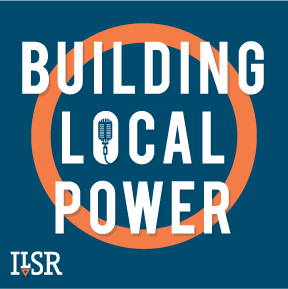 Like this episode? Please help us reach a wider audience by rating Building Local Power on iTunes or wherever you find your podcasts. And please become a subscriber! If you missed our previous episodes make sure to bookmark our Building Local Power Podcast Homepage.
Like this episode? Please help us reach a wider audience by rating Building Local Power on iTunes or wherever you find your podcasts. And please become a subscriber! If you missed our previous episodes make sure to bookmark our Building Local Power Podcast Homepage.
If you have show ideas or comments, please email us at info@ilsr.org. Also, join the conversation by talking about #BuildingLocalPower on Twitter and Facebook!
Subscribe: iTunes | Android | RSS
Audio Credit: Funk Interlude by Dysfunction_AL Ft: Fourstones – Scomber (Bonus Track). Copyright 2016 Licensed under a Creative Commons Attribution Noncommercial (3.0) license.
Follow the Institute for Local Self-Reliance on Twitter and Facebook and, for monthly updates on our work, sign-up for our ILSR general newsletter.





